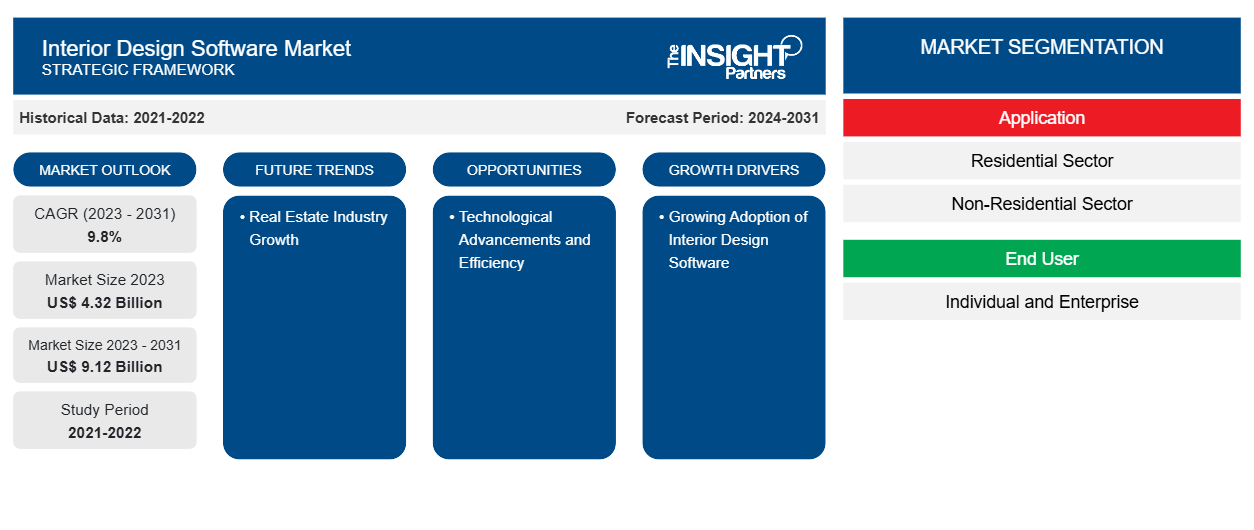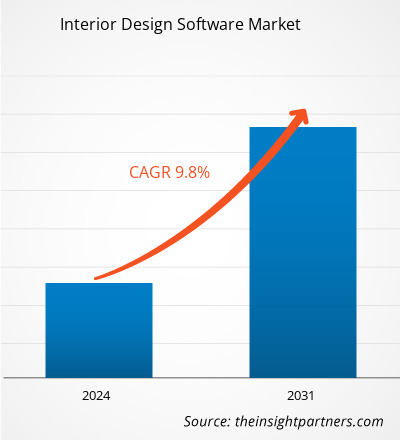Interior Design Software Market Share and Forecast by 2031
Historic Data: 2021-2022 | Base Year: 2023 | Forecast Period: 2024-2031Interior Design Software Market Size and Forecast (2021 - 2031), Global and Regional Share, Trend, and Growth Opportunity Analysis Report Coverage: By Application (Residential Sector and Non-Residential Sector), and End User (Individual and Enterprise), and Geography
- Report Date : Mar 2026
- Report Code : TIPRE00017545
- Category : Technology, Media and Telecommunications
- Status : Data Released
- Available Report Formats :


- No. of Pages : 150
The interior design software market size is projected to reach US$ 9.12 billion by 2031 from US$ 4.32 billion in 2023. The market is expected to register a CAGR of 9.8% during 2023–2031. Real estate industry growth is likely to remain a key trend in the market.
Interior Design Software Market Analysis
The increasing demand for more productivity is one of the major factors driving this market. Also, increasing demand for better interior design and decoration and rising usage of cloud-based software boost the growth of the market. Interoperability issues associated with interior design software limit the growth of this market. Furthermore, the growth of the virtualization process and the demand for interior design software, which is growing at a fast rate in countries such as China, are expected to provide multiple opportunities to the market.
Interior Design Software Market Overview
The interior design software allows architects to make an early estimation of the quality of the internal environment. The architects can also use this software to identify, track, and measure any deviation of the designed building from the required criteria. This software further allows architects to take preventative measures to reduce the need for renovation and reconstruction. It also has a comprehensive collection of options, such as designs for windows, doors, beds, and tables, which a designer can use to make an exact model of the room.
Customize This Report To Suit Your Requirement
You will get customization on any report - free of charge - including parts of this report, or country-level analysis, Excel Data pack, as well as avail great offers and discounts for start-ups & universities
Interior Design Software Market: Strategic Insights

-
Get Top Key Market Trends of this report.This FREE sample will include data analysis, ranging from market trends to estimates and forecasts.
Interior Design Software Market Drivers and Opportunities
Growing Adoption of Interior Design Software
A key growth driver for the interior design software market is the increasing use of such software by architects, engineers, and contractors. It contributed significantly during the early designing stages for assessing the interiors. It reduces errors, enables effective time management, and shows any differences from a proposed design to actual construction, enhancing overall efficiency and accuracy in its work by setting floor plans, furniture, and interior decors into a realistic, three-dimensional environment.
Technological Advancements and Efficiency
The sudden rise in global construction activities, which came through simultaneously with the broad adoption of interior design software to bring improvement in operational efficiency, highly accelerates growth in the interior design services sector. This trend is further reinforced by the ability of this software to speed up the design process, save time and costs, and offer an extensive collection of furniture choices that let designers make accurate and realistic room models. Thus, the growing integration of interior design software is not only easing operations but also contributing to the absolute growth of the market.
Interior Design Software Market Report Segmentation Analysis
Key segments that contributed to the derivation of the interior design software market analysis are application and end users.
- Based on application, the market is bifurcated into residential sector and non-residential sector. The residential sector segment held a significant market share in 2023.
- Based on end users, the market is segmented into individual and enterprise. The enterprise segment held a significant market share in 2023.
Interior Design Software Market Share Analysis by Geography
The geographic scope of the interior design software market report is mainly divided into five regions: North America, Asia Pacific, Europe, Middle East & Africa, and South & Central America.
The regional overview of the interior design software market reveals significant growth opportunities in various regions. In the Asia-Pacific, the rise in population and urbanization, particularly in major cities such as Tokyo, Beijing, and Mumbai, has led to an increased focus on residential sectors, with initiatives such as China's national development strategy aiming for substantial urbanization. Furthermore, the Asia Pacific is projected to register the highest CAGR in the market during the forecast period, attributed to increasing building infrastructure plans in countries such as China and India, as well as growing urbanization and population expansion in major cities such as Beijing, Tokyo, and Mumbai.
Interior Design Software Market Regional Insights
The regional trends and factors influencing the Interior Design Software Market throughout the forecast period have been thoroughly explained by the analysts at The Insight Partners. This section also discusses Interior Design Software Market segments and geography across North America, Europe, Asia Pacific, Middle East and Africa, and South and Central America.
Interior Design Software Market Report Scope
| Report Attribute | Details |
|---|---|
| Market size in 2023 | US$ 4.32 Billion |
| Market Size by 2031 | US$ 9.12 Billion |
| Global CAGR (2023 - 2031) | 9.8% |
| Historical Data | 2021-2022 |
| Forecast period | 2024-2031 |
| Segments Covered |
By Application
|
| Regions and Countries Covered |
North America
|
| Market leaders and key company profiles |
|
Interior Design Software Market Players Density: Understanding Its Impact on Business Dynamics
The Interior Design Software Market is growing rapidly, driven by increasing end-user demand due to factors such as evolving consumer preferences, technological advancements, and greater awareness of the product's benefits. As demand rises, businesses are expanding their offerings, innovating to meet consumer needs, and capitalizing on emerging trends, which further fuels market growth.

- Get the Interior Design Software Market top key players overview
Interior Design Software Market News and Recent Developments
The interior design software market is evaluated by gathering qualitative and quantitative data post primary and secondary research, which includes important corporate publications, association data, and databases. A few of the developments in the interior design software market are listed below:
- IKEA U.S. announced the launch of IKEA Interior Design Service, a brand-new program that offers professional, one-on-one interior design at an affordable price. Consumers and businesses will have the opportunity to connect with an expert to design any space with creative solutions.
(Source: Inter IKEA Systems B.V., Company Website, April 2023)
- Ingka Group, the largest IKEA retailer, today launches its new, AI-driven digital design experience, IKEA Kreativ. The intuitive new experience offers customers the first lifelike, fully integrated way to design and visualize their own living spaces from computers and smartphones.
(Source: Inter IKEA Systems B.V., Company Website, July 2022)
Interior Design Software Market Report Coverage and Deliverables
The “Interior Design Software Market Size and Forecast (2021–2031)” report provides a detailed analysis of the market covering below areas:
- Interior design software market size and forecast at global, regional, and country levels for all the key market segments covered under the scope
- Interior design software market trends, as well as market dynamics such as drivers, restraints, and key opportunities
- Detailed PEST/Porter’s Five Forces and SWOT analysis
- Interior design software market analysis covering key market trends, global and regional framework, major players, regulations, and recent market developments
- Industry landscape and competition analysis covering market concentration, heat map analysis, prominent players, and recent developments in the interior design software market
- Detailed company profiles
Frequently Asked Questions
What is the expected CAGR of the interior design software market?
What would be the estimated value of the interior design software market by 2031?
Which are the leading players operating in the interior design software market?
What are the future trends in the interior design software market?
What are the driving factors impacting the interior design software market?
Ankita is a dynamic market research and consulting professional with over 8 years of experience across the technology, media, ICT, and electronics & semiconductor sectors. She has successfully led and delivered 100+ consulting and research assignments for global clients such as Microsoft, Oracle, NEC Corporation, SAP, KPMG, and Expeditors International. Her core competencies include market assessment, data analysis, forecasting, strategy formulation, competitive intelligence, and report writing.
Ankita is adept at handling complete project cycles—from pre-sales proposal design and client discussions to post-sales delivery of actionable insights. She is skilled in managing cross-functional teams, structuring complex research modules, and aligning solutions with client-specific business goals. Her excellent communication, leadership, and presentation abilities have enabled her to consistently deliver value-driven outcomes in fast-paced and evolving market environments.
- Historical Analysis (2 Years), Base Year, Forecast (7 Years) with CAGR
- PEST and SWOT Analysis
- Market Size Value / Volume - Global, Regional, Country
- Industry and Competitive Landscape
- Excel Dataset
Recent Reports
Related Reports
Testimonials
The Insight Partners' SCADA System Market report is comprehensive, with valuable insights on current trends and future forecasts. The team was highly professional, responsive, and supportive throughout. We are very satisfied and highly recommend their services.
RAN KEDEM Partner, Reali Technologies LTDsI requested a report on a very specific software market and the team produced the report in a few days. The information was very relevant and well presented. I then requested some changes and additions to the report. The team was again very responsive and I got the final report in less than a week.
JEAN-HERVE JENN Chairman, Future AnalyticaWe worked with The Insight Partners for an important market study and forecast. They gave us clear insights into opportunities and risks, which helped shape our plans. Their research was easy to use and based on solid data. It helped us make smart, confident decisions. We highly recommend them.
PIYUSH NAGPAL Sr. Vice President, High Beam GlobalThe Insight Partners delivered insightful, well-structured market research with strong domain expertise. Their team was professional and responsive throughout. The user-friendly website made accessing industry reports seamless. We highly recommend them for reliable, high-quality research services
YUKIHIKO ADACHI CEO, Deep Blue, LLC.This is the first time I have purchased a market report from The Insight Partners.While I was unsure at first, I visited their web site and felt more comfortable to take the risk and purchase a market report.I am completely satisfied with the quality of the report and customer service. I had several questions and comments with the initial report, but after a couple of dialogs over email with their analyst I believe I have a report that I can use as input to our strategic planning process.Thank you so much for taking the extra time and making this a positive experience.I will definitely recommend your service to others and you will be my first call when we need further market data.
JOHN SUZUKI President and Chief Executive Officer, Board Director, BK TechnologiesI wish to appreciate your support and the professionalism you displayed in the course of attending to my request for information regarding to infectious disease IVD market in Nigeria. I appreciate your patience, your guidance, and the fact that you were willing to offer a discount, which eventually made it possible for us to close a deal. I look forward to engaging The Insight Partners in the future, all thanks to the impression you have created in me as a result of this first encounter.
DR CHIJIOKE ONYIA MANAGING DIRECTOR, PineCrest Healthcare Ltd.Reason to Buy
- Informed Decision-Making
- Understanding Market Dynamics
- Competitive Analysis
- Identifying Emerging Markets
- Customer Insights
- Market Forecasts
- Risk Mitigation
- Boosting Operational Efficiency
- Strategic Planning
- Investment Justification
- Tracking Industry Innovations
- Aligning with Regulatory Trends




















 Get Free Sample For
Get Free Sample For